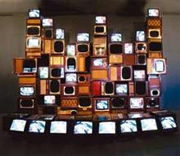
Art and the Moving Image, 1963-1986
First Generation: Art and the Moving Image, 1963-1986 is the title of a recently opened show at the Museo Nacional Centro de Arte Reina Sofia, Madrid. It assembles early video and video performance work mainly focusing from their own collection with emphasis on specific approaches to the medium during the first 25 years. It includes as main themes the inspiration of Fluxus, the critique of commercial television, the relationship between the medium and the viewer, feminism, performance and the legacy of minimalism and conceptual art.
First Generation does not aspire to be a thematic exhibition, nor does it try to follow a strict chronological order. Rather, it is a global vision of how and why a technology of recording, broadcasting and reproducing sound and images, which emerged in 1950 --and technically different than cinema-- became an artistic medium;
a 'study' of the influence technology and mass culture had on the social and artistic changes of an era, at a time when cultural acceleration and the cross-pollination of ideas was beginning. In this sense, 1968 marks a before and after in this history: for that was the year in which a portable, relatively affordable television set appeared on the market, opening this medium up to a vast new group of people.
Interesting in this context might be as well the link to the complete archive of the early media magazine Radical Software:
The historic video magazine Radical Software was started by Beryl Korot, Phyllis Gershuny, and Ira Schneider and first appeared in Spring of 1970, soon after low-cost portable video equipment became available to artists and other potential videomakers... [blogged on mind the __GAP*?] [Related]

